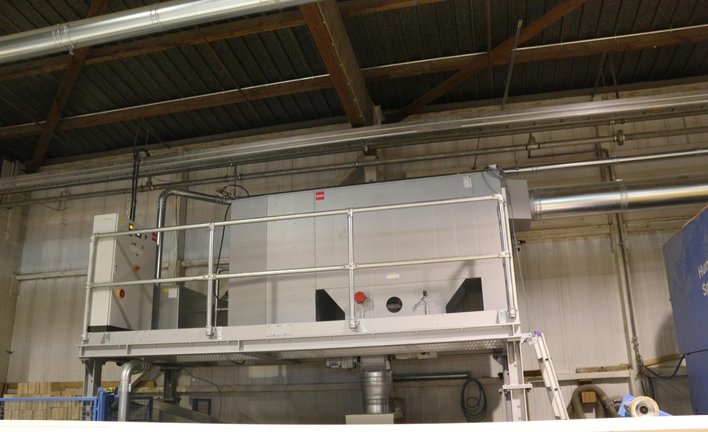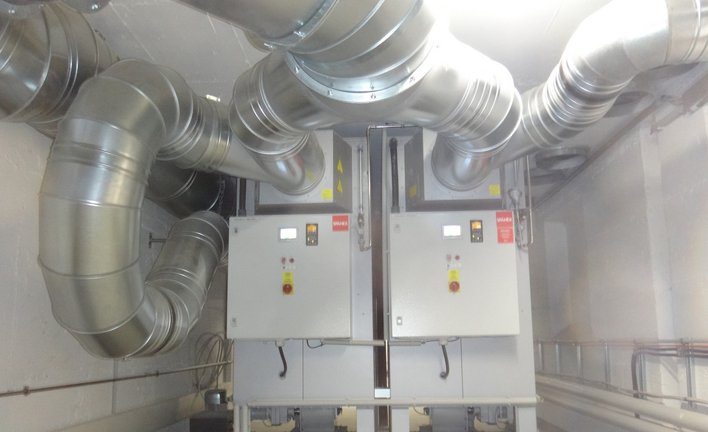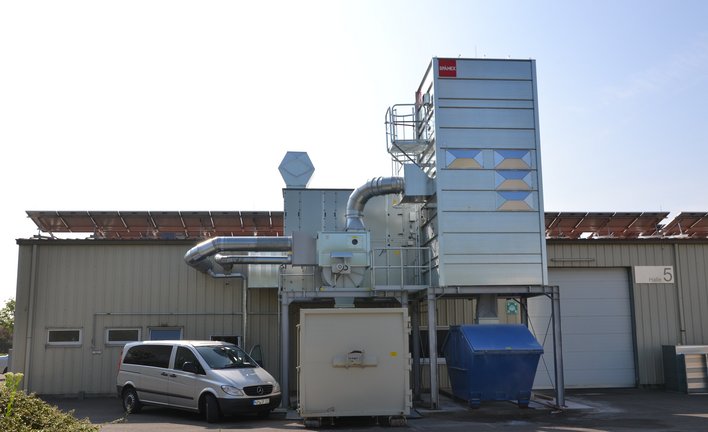Extraction for
aluminium chips

1. General
In the aluminium industry, the importance of the new production processes that manage without or with small quantities of cooling lubricants continues to increase. The chips produced can often be extracted directly and fed to a filter system via a piping system.
The targeted collection and removal of the chips is the prerequisite for effective extraction.
As a rule, the processing machines are already equipped with extraction hoods that are to be connected to the piping system of the extraction system. The machine manufacturers specify the data to be complied with in terms of extraction (extraction volume flow, suction pressure). Some old machines do not meet these requirements, so that on-site tests are necessary to design and optimally position the extraction hoods and to determine the characteristics..
2. Innovative extraction systems
The decisive factor for the extraction system is the required extraction volume flow. Dust extractors are generally used up to 10,000 m³/h, although larger air volumes can also be achieved by combining several dust extractors.
Dust extractor solutions (Fig. 1) have the charm that these units can be set up directly in the working area. The dust extractors are compact extraction units with the following features:
High suction power,
Low energy consumption,
Quiet operation,
Effective filter and cleaning technology,
Compactness,
Tested safety,
Several disposal options,
Delivery largely ready for operation.
For extraction volume flows above 10,000 m³/h, central, externally installed filter systems (Fig. 2) are the primary alternative solution..
The filter units also represent compact extraction units with integrated, energy-efficient high-performance fans, which as individual units cover the volume flow range up to 40,000 m³/h. The other features of this unit series are:
Variety through a modular system,
Optimum adaptability to customer conditions,
High suction power,
Use of high-performance fans,
Quiet operation,
Effective filter and cleaning technology,
Several disposal options,
Pre-assembly in the factory
What modern extraction systems have in common today is that they use intelligent control and regulation technology to adapt the extraction power to the demand and thus ensure energy-efficient operation. The demand-adapted extraction capacity is achieved by changing the speed of the extraction fans by operating the motors via frequency converters..
From the experience of the large number of speed-controlled extraction systems already supplied by SPÄNEX, we can say that in real operation on average only approx. 50 - 60 % of the installed motor power is required.



3. Exemplary solution from practice
The customer's machines are used to process extruded profiles on circular saws and milling machines. 3 dust extractors were supplied for the extraction of the individual production lines..
The dust extractors are placed on supports. The aluminium chips buffered in the containers of the dust extractors are transferred to a conveyor belt via slide valves. The conveyor belt detects the 3 discharging points of the dust extractors and transports the collected aluminium chips to a centrally located container. The entire extraction system has a capacity of 18,000 m³/h.
All dust extractors are equipped with frequency converters that always provide a constant extraction power, regardless of the operating conditions. The regulation and control technology recognises the respective demand situation and provides the corresponding control signals for the frequency converters. The changing resistances of the filter system during processing are also regulated and the extraction power is thus kept constant.
The operating results and experience show that not only excellent results have been achieved in terms of chip collection, but also the availability and thus also the productivity of the processing machines have been significantly increased..
4. Summary
These explanations should have shown that SPÄNEX can design and implement interesting overall solutions for the extraction and disposal of aluminium chips for aluminium processing.
Advantages at a glance
- Customised advice and planning
- Several extraction solution alternatives
- Extraction capacity adapted to requirements
- Effective filter and cleaning technology
- Several disposal options
- Quiet operation
- Pre-assembly in the factory